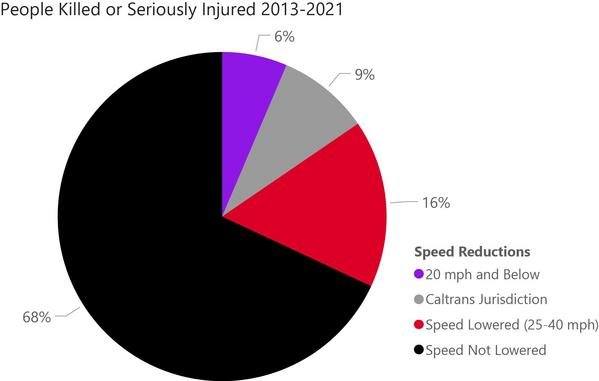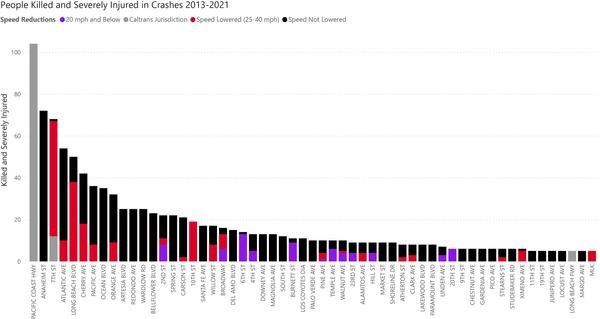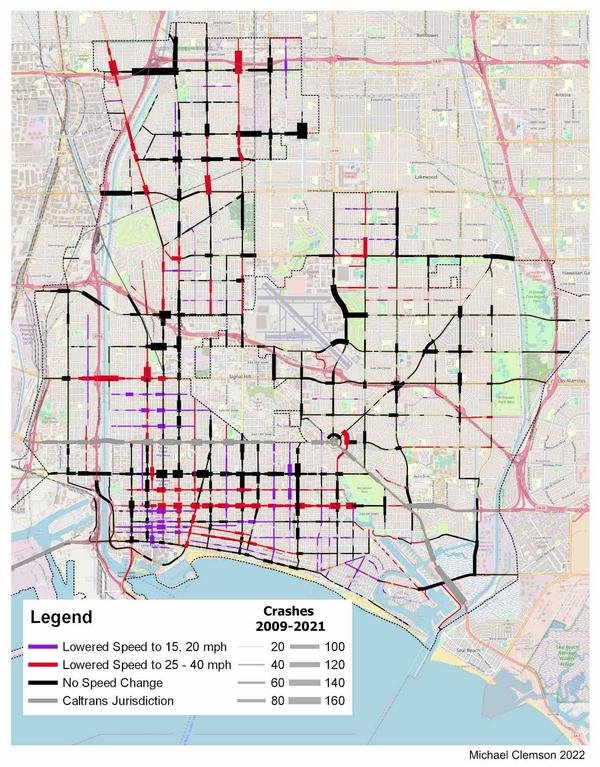Michael Clemson is the Secretary/Treasurer of the Long Beach Transit Board of Directors, and manages the statewide transportation program for the California State University Chancellor’s Office.
Deaths from car crashes, especially pedestrian and cyclist deaths, spiked across the country since the pandemic. Drivers were encouraged to speed when lockdowns cleared roads of speed-limiting traffic. Combined with larger and larger vehicles and a rise in anxiety levels, drinking and substance abuse have led to deadlier roads.
To try and stop this, the city adopted the Safe Streets Long Beach Vision Zero Action Plan in July 2020 with the goal of eliminating traffic deaths by 2026. The main theme is that speed is most common cause of the severe crashes and deaths.
While the pandemic delayed most progress toward implementation, a major element was approved by the City Council in December. On the agenda is a proposal to reduce speeds on parts of 68 Long Beach streets, including Seventh St, one of the most dangerous streets in the city. This is clearly a welcome and critical move in implementing the long-delayed Vision Zero plan, but it also leaves the most dangerous streets untouched.

42% of the miles in the speed reduction plan are on 25 mph streets but the city’s Safe Streets Plan shows that only 17% of the serious injuries and deaths happen on those type of streets. The other 83% are on streets with higher speed limits. Usually these are arterials, which are built to wide and straight streets that quickly move a lot of traffic, the plan shows that they are especially dangerous and causing more serious injury and fatal crashes.
Both PCH and Anaheim St are the most dangerous streets for everyone: cyclists, pedestrians, and drivers. These two streets have been the most dangerous for generations. Back in 1947, they made up about 15% when the Long Beach Independent ran the headline “Death Rides Most on Anaheim, PCH”.
The City’s speed reduction proposal leaves speeds on these and other dangerous streets unchanged. Part of this is because Pacific Coast Highway is controlled by Caltrans, whose first job is keeping cars moving.

But other streets are unchanged because the city prioritizes high speeds and traffic on major streets. There were no speed reductions on streets like Anaheim, Redondo, Spring, Ocean, and Pacific and other notoriously dangerous streets. Most residential streets also didn’t have their speeds reduced.
Between 2009 and 2021, 75% of crashes happened on streets where the city isn’t changing the speed. Clearly, not every crash is caused by speed, but speeding is rampant enough that it at least partially causes most crashes and makes crashes more deadly. Since the pandemic lockdowns cleared streets, speeding has increased significantly and with it so have traffic deaths. In fact, the unofficial tally for 2022 is 42 people killed in car crashes, which is the worst year for traffic deaths since 1993. Too many of those deaths are on streets where the speed limit isn’t changing.
Many people don’t see speeding as dangerous or socially unacceptable. Preventing speeding using policing and ticketing doesn’t reliability change behavior since many don’t believe they will not be caught and even if they do, the police are only ticketing them as a conspiracy to get quick cash for the city.
They’re almost certainly right that they won’t get caught, speeding is constant and widespread and Long Beach is a big city. Its too expensive to station a patrol at every intersection. Once the officer is gone, any motivation not to speed is gone too.

That’s why building safe street infrastructure is so important to making streets safer in the long term. Dropping speed limits are an important first step and need to be done on Long Beach’s most dangerous streets, but streets need to be built to make drivers actually follow that speed limit.
Streets can be designed to tell drivers that they are guests in a pedestrian area and make it clear that they need to drive safely because they are in a place for people. These designs can help slow traffic, including narrow streets without curbs and sidewalks with trees, planters and even parking. Since one of the biggest reasons that people don’t walk is high-speed traffic, designing the street to slow cars using narrower lanes is critical.
As cities put car traffic ahead of people, streets became increasingly dangerous and then deserted people walking. As more traffic leads to people seeing the street as more dangerous, they are less likely to walk, which adds more traffic to streets and makes it more dangerous to walk.
Without the city building safer streets, this vicious cycle will continue to leave fewer and fewer people walking and streets more and more choked with traffic. We should start by looking at our most dangerous streets first.


